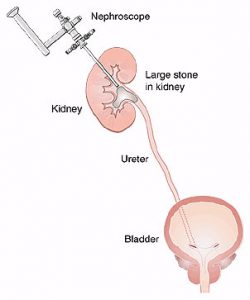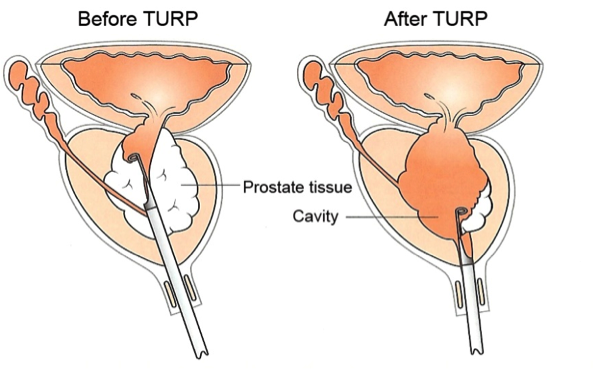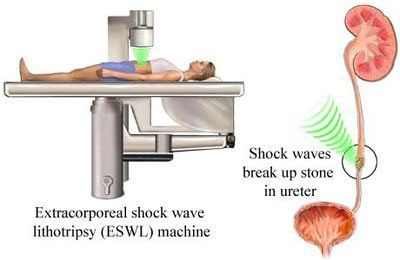
Urology
Department of Urology offers comprehensive care to Patients suffering from the diseases of the urinary system.Urinary System includes primarily the diseases of the kidneys, ureter (tubes bringing urine to the bladder), urinary bladder, prostate and the urethra.Our urology department also cares for patients with certain problems of the adrenal glands, male external genitalia and male fertility problems.
The department has state of art facilities for Endoscopic, Laparoscopic and LASER Procedures.
Minimally Invasive Surgical Procedures commonly performed
- PCNL and URS (Removal of kidney and ureteric stones) – All stones in the urinary tracts are removed endoscopically either by making puncture in the kidney (PCNL or PNL) or going through the urinary meatus( where a person passes urine) which is called ureteroscopy either flexible or semi-rigid. Stone is fragmented with help of pneumatic burr or laser and removed with the help of forceps or baskets. There is hardly any scope to cut open any patients belly to remove stones.
- TURP (For Prostate problems) – for treatment of prostatic enlargement.
- TURBT (for bladder cancer)
- LASER treatment for stones and prostate
- Laparoscopic surgeries (using latest state of the art 3D Karl Storz Laparoscopy system from Germany with great precision) of the Urinary system like Nephrectomy, Pyeloplasty, Ureterolithotomy, Pyelolithotomy, VVF repair, Renal cyst
- Reconstructive Procedures performed such as Urethral Stricture Disease, pyeloplasty.
- Cancer surgeries for the Urinary system
- Pediatric urology like hypospadiasis and undescended testis surgery
- Female urology like surgery for stress urinary incontinence and vesicovaginal fistula
- Lithotripsy (ESWL)– for non surgical treatment of stones
- Fertility problems, testicular biopsy, varicocele surgery, vasectomy, vasectomy reversal
What is PCNL?
 A Percutaneous Nephrolithotomy (PCNL). is an operation to remove stones from the kidney. It is a form of keyhole surgery so is performed through a small cut in the skin. This means you will have a small scar afterwards. The procedure is carried under general anaesthetic (you are asleep). PCNL is used for the treatment of stones in the kidney which are not suitable for other, less invasive treatments because they are too large, too hard or associated with abnormal kidneys. PCNL is a highly effective method of treating kidney stones. The success rate is between 75% and 99%.
A Percutaneous Nephrolithotomy (PCNL). is an operation to remove stones from the kidney. It is a form of keyhole surgery so is performed through a small cut in the skin. This means you will have a small scar afterwards. The procedure is carried under general anaesthetic (you are asleep). PCNL is used for the treatment of stones in the kidney which are not suitable for other, less invasive treatments because they are too large, too hard or associated with abnormal kidneys. PCNL is a highly effective method of treating kidney stones. The success rate is between 75% and 99%.
Before Operation
You will be admitted to the ward on the day before or on the day of the operation, depending on your medical history. On the morning of your procedure the anaesthetic team will visit and review you. You will need to sign a consent form for surgery. Before you sign this, please ensure that you fully understand the procedure and its possible risks. If you have any questions or concerns, please talk to your surgical team.
How is the operation performed?
Using x-ray guidance, an access is made to track down to the kidney through a small cut in the skin. A surgical telescope (nephroscope) is passed into the kidney and used to see your stone. The stone is then broken into small pieces which are removed. At the end of the procedure a drain called a nephrostomy tube is left in the kidney. The fluid which comes out is likely to be blood-stained initially and tends to clear after a day or two. PCNL usually takes 1-2 hours.
After Operation
After the operation you should move your feet and wriggle your toes to help promote circulation in your legs. This will reduce the risk of blood clots forming (venous thromboembolism). You will be able to eat and drink, after surgery, as soon as you feel like it. Your urologist may choose to have additional X-rays done while you are still in the hospital to determine if any stone fragments are still present.The tube is removed after a day or two depending on the procedure. This leaves a small wound It is important to drink plenty of fluids.
What is TURP?
 The Prostate gland is at the base of the Bladder and surrounds the urinary passage (urethra). The normal function of the gland is to produce some of the seminal fluid, which is expressed with ejaculation.
The Prostate gland is at the base of the Bladder and surrounds the urinary passage (urethra). The normal function of the gland is to produce some of the seminal fluid, which is expressed with ejaculation.
TURP operation removes the gland and thus allows free passage of urine from the bladder. The operation is done under anesthesia using a special instrument called a Resectoscope. Because there is no cut in the skin, healing after the operation is quicker. It may still be necessary however, to leave a catheter to drain the bladder for 1-2 days. The procedure is done as a overnight stay in Hospital unless other concomitant ailments dictate a longer stay. If the prostate gland is very large, it may be necessary to remove the gland by a cutting operation in the lower abdomen. If this method is preferred, our surgeon will explain the details.
What is Lithotripsy (ESWL) Procedure?
 A method of treating kidney and ureteric stones without surgery, using the latest Siemens lithotripter machine from USA One of the best machines available for the purpose. Both x-ray & Ultrasound controls are available on this machine. The positioning, focussing and delivery of shock waves are all controlled by advanced computerized system with safety cut-offs to prevent damage by human error. Patients does not need any hospital stay and can go home same day.
A method of treating kidney and ureteric stones without surgery, using the latest Siemens lithotripter machine from USA One of the best machines available for the purpose. Both x-ray & Ultrasound controls are available on this machine. The positioning, focussing and delivery of shock waves are all controlled by advanced computerized system with safety cut-offs to prevent damage by human error. Patients does not need any hospital stay and can go home same day.
What is URS?
This treatment involves the use of a very small, fiber-optic instrument called an ureteroscope, which allows access to stones in the ureter or kidney. The ureteroscope allows your urologist to directly visualize the stone by progressing up the ureter via the bladder. allows your urologist to directly visualize the stone by progressing up the ureter bladder. No incisions are necessary. Once the stone is seen through the ureteroscope, a small, basket-like device can be used to grasp smaller stones and remove them. If a stone is too large to remove in one piece, it can be fragmented into smaller pieces.
Once the stone has been completely treated, the procedure is done. In many cases, the urologist may choose to place a stent within the ureter, to allow any post-operative swelling or reaction to subside.
Patients normally go home the same day and can resume normal activity in two to three days. As with SWL, if your urologist places a stent, it will need to be removed in approximately 2-4 weeks.
Meet Our Doctors

